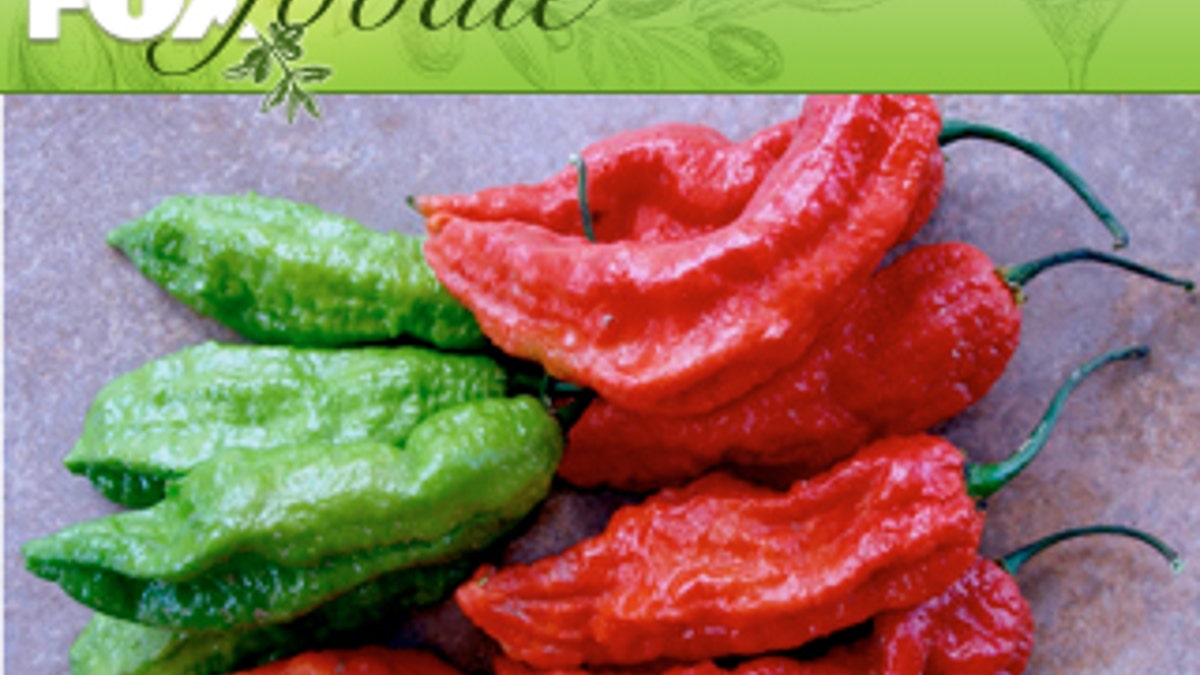
Bhut Jolokia Peppers (The Chili Pepper Institute at New Mexico State University)
Where there’s fire there’s heat, and sometimes there’s even booze, like at Salvador Molly’s “Great Ball of Fire” contest. Salvador Molly’s in Portland, Oregon is serious about heat. Cold beer, serious. Cold milk, serious. “Toughest Tongue in the West,” serious. $7.95 gets you five minced habanero pepper fritters mixed with cotija, a Mexican cow’s milk cheese that’s mixed with spices. Down all five and you’re in the “Hall of Flame,” says co-owner and general manager Darrielle Sadle-Ruff. “And you’ve got to eat them with our ‘Sunshine and Pain’ salsa - hotter than the fritter,” she laughs. She’s only ever managed to eat one.
Thirteen years ago Darrielle’s father, Rick Sadle and original chef, Scott Moritz opened “Salvador Molly’s Tamale Cart” at the Portland Farmer’s Market. The cart became a café and the café a family restaurant, bar and hangout. The hot pepper contest originated as a way of having fun then became a way of doing good. Every February, all “Great Balls of Fire” proceeds go to Oregon Heat, a non-profit that helps families settle their heating bills. This local and highly idiosyncratic contest now attracts heat-seekers from all over the US. “It brings all sorts of fun people through our doors. They’re interested in the challenge aspect of it,” says Sadle-Ruff. The challenge interests them, but it’s the capsaicin that hooks them.
Capsaicin, says Danise Coon, Program Coordinator and Research Specialist at New Mexico State University’s Chile Pepper Institute, is the alkaloid that makes peppers hot. New Mexico is the U.S.’s top chile producer and the Institute is dedicated to raising our collective chile I.Q. Coon got a student job there while working towards an Ornamental Horticulture degree. Fifteen years later, she’s still there, still passionate about hot peppers. The pepper’s capsaicinoids, she says, bind with pain receptors in the mouth and throat that are responsible for sensing heat and convince your brain that you’ve eaten some sort of culinary lava. “Your brain literally thinks you’re on fire,” she says.
Your brain tries to put a whole of gone between your body and that pepper by speeding up heart rate and metabolism, firing up perspiration and salivation. You sweat, your nose runs, your eyes water, your gastrointestinal tract obeys no speed limit. And when it feels as if your sinuses have vaporized and your eardrums are on fire, your brain releases endorphins, opiate-like chemicals that reduce pain and induce a sense of well-being.
We enjoy eating hot peppers, says Coon, for the same reason that runners run - the endorphin-flooding runner’s high. Heat aficionados get the same endorphin high minus the bodily wear-and-tear and shin splints.
Hot or not, Coon wants you to know that “chili” and “chile” are not interchangeable. “Chili” is a culinary dish consisting of chile powder, beans, tomato and ground beef. “Chile” is anything consisting of the capsicum plant or the fruit from that plant. Chiles belong to the nightshade family along with tomatoes, potatoes and eggplants. Those mild foods also have capsaicin alkaloids but only in their leaves, stems and roots. In chiles they’re inside the fruit itself, specifically in the fruits’ placenta, the white soft tissue that the seeds are attached to. The heat is not, as many people think, in the seeds.
Chiles originated in a remote area between Bolivia and Brazil, she says, and were spread painlessly by foraging and migrating birds as they lack capsaicin pain receptors in their mouths. Chiles were initially used medicinally before being integrated into food. According to “The Complete Chili Pepper Book” by Dave DeWitt and Paul Bosland, “archeological evidence from Mexico indicates that humans have possibly been using wild chile peppers as a food source for at least 7200 years.” Today they’re used in everything from lipstick and to food dyes, to disposable heat wraps, riot-quelling sprays and keeping flamingoes feathers pink. And of course, food.
A pepper’s “pungency,” its capsaicin level, is expressed in SHU, Scoville Heat Units. Guinness’ hottest pepper on record, the Bhut Jolokia (“ghost chile”) from Assam, India, and discovered by Chile Pepper Institute scholar, Paul Bosland, measures a blistering 855,000 to 1,050,000 SHU. (The Infinity Chile, bred in Grantham, UK earlier this month measured 1,067,000 SHU but is so far unconfirmed by Guinness). The Red Savina rates 300,000 to 550,000 SHU. Habaneros and Scotch Bonnets ring in at 100,000 to 350,000 SHU. Jalapenos, the hot peppers most familiar to us are a mere 2500 to 8000 SHU. “Law enforcement grade” pepper spray ranges from 5,000,000 to 5,300,000 SHU. Pure capsaicin? At 16,000,000 SHU, don’t even think about it.
If you’re an internal thermodynamic conflagration fan and can’t get to Salvador Molly’s, CaJohn’s Fiery Foods of Columbus, Ohio has “Holy Jolokia” hot sauce made from Bhut Jolokias. It’s more of a Louisiana style, mash-based hot sauce says Coon. “The pain is intense so we toned it down,” she says. “We didn’t want it to melt your face off.” A percentage of each sale funds further research and education at the Chile Pepper Institute.
Meltdown Maven, Sadle-Ruff, says pineapple juice better neutralizes hot peppers than cold beer and cold milk. “We actually have people sign a release before eating saying that they’re responsible for freely ingesting the fritters,” she chuckles. She says it’s just a matter time before Bhut Jolokias debut at Salvador Molly’s. They’ll undoubtedly gain a following. One man’s intestinal inferno is another man’s pleasure.
